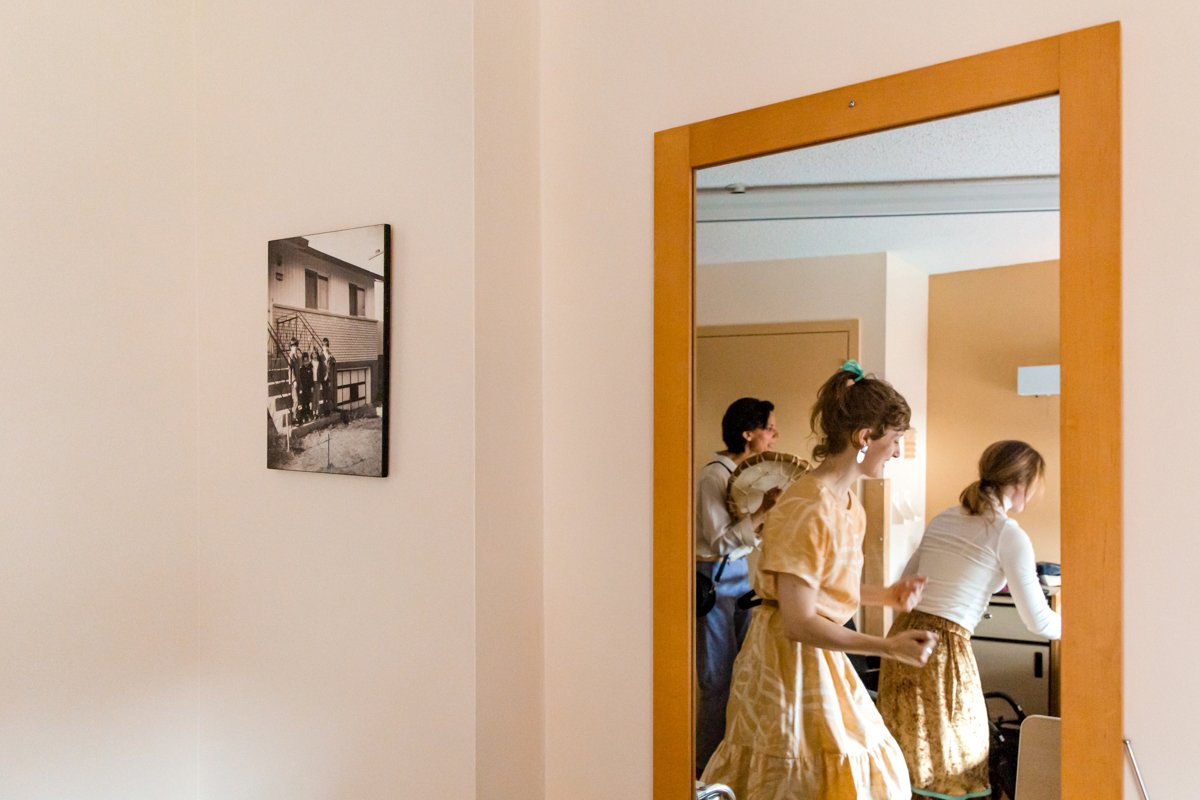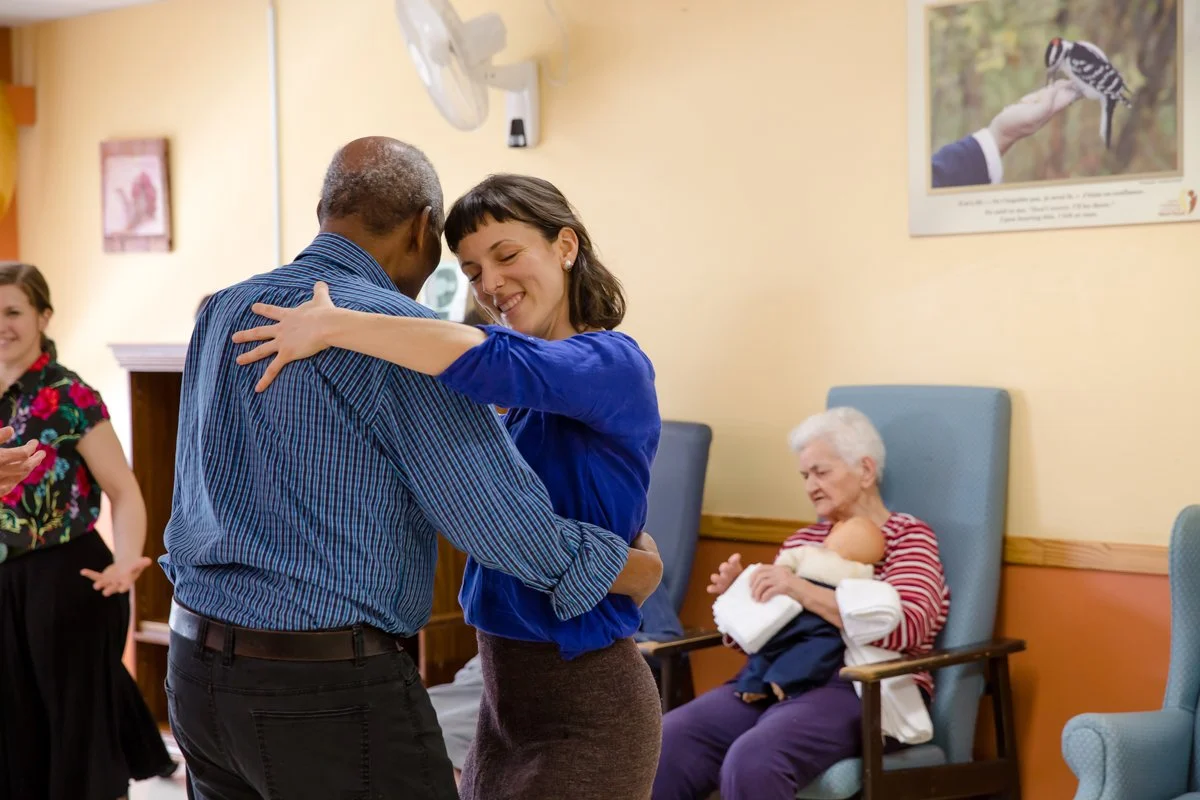
stories and reflections from the field
*
stories and reflections from the field *
A wonderful procession
Sometimes, certain residents don’t want to let us go when we leave their room. They follow us down the corridor, and our visit turns into a wonderful procession.
Audrey Bergeron, Dancer
Chit-chat
Some residents love to chat. “There’s some beautiful snow, huh?”—and just like that, I begin to move in a way that evokes falling snowflakes. Their words become a tool to invite them into my dancing world.
Georges-Nicolas Tremblay, Dancer
Meeting where they are
If the person I’m connecting with wants to imagine that the stuffed animal on their bed is a real cat, then all the better! I welcome these moments of fantasy as expressions of joy. If I try to bring them “back to reality,” I risk causing confusion, discomfort or even shame. I prefer to meet them where they are and create a dance that flows with their reality.
Julie Tymchuk, Dancer
The thread
Weaving a work from the invisible thread that connects us shows just how simple it is to relate when we want nothing and have no expectations of who the other should be.
Ariane Boulet, Founder and Dancer
Party
I attended my first dance visit as an observer at a CHSLD in Hochelaga. In the common room, the residents’ expressions were somber, their movements measured. When the dancers and musician arrived, the atmosphere suddenly changed—this pure energy just swept through the room. The residents rose from their chairs and began singing and dancing. The party was in full swing. I danced with a woman. We smiled as we looked into each other’s eyes. Life sparkled in hers, it flowed through her worn body, and honestly, it moved me deeply to feel so much tenderness for a stranger—a stranger I began to see as precious.
Mélina Schoenborn, Project Manager
Soundtrack
I use instruments that mean a lot to me and are easy to walk with in the corridors and rooms: the kalimba, a drum, chimes and my voice. The kalimba, with its ethereal and mysterious sound, brings softness and calm. It invites residents to be moved from within. The drum is more dynamic and rhythmic—I use it when I feel a need for grounding or the moment calls for an invitation to party! The beep-beep-beep of the medical devices, a staff member speaking, a cart rolling by... All these sounds become part of the visit’s soundtrack.
Marie Vallée, Musician
Thank you
One day, while I was dancing in the corridor, I caught sight of a woman in her room, sitting by the window. She was resting her head on her arms, lost in thought with a faraway gaze. I entered her room and placed my hand on hers, and it was as if we were suddenly transported to the same place: her world. Together, we moved our hands in a dance. She stood up and swayed like wisps of smoke. It was so beautiful. At the end, the woman said to me, “Thank you—I felt so alone.”
Isabelle Poirier, Dancer
Duet
A man was bedridden. I extended my arms toward him. The man held me for support and stood up to join me for a long duet. He told me that it was the first time he had danced with another man.
Georges-Nicolas Tremblay, Dancer
Tenderness
I give my energy, but feel like I receive just as much in return. The residents care for me too, stroking my hand, offering maternal gestures of affection. Tenderness shines through.
Joannie Douville, Dancer
Ego
As an artist, I approach residents with the best of intentions… but it doesn’t always have the intended effect. I might be met with rejection, aggression or anxiety. I think it’s important to welcome the physical and emotional discomfort when it arises, and to let go of the ego and desire to perform.
Jimmy Gagnon, Musician
Breathing
Sometimes I meet residents whose bodies have endured significant suffering and are holding a lot of tension. I remember a woman who had had sponges placed between her fingers to prevent her from crushing her own bones during spasms. I put my hand on her shoulder and simply breathed with her.
Lucy M. May, Dancer
The vast world
I could feel G.’s fingers trembling. The tremours carried through into our dance. Following his trance, our arms began to float and drift together in the air, our fingers interlaced, calm. Our eyes stayed on each other. His gaze was somehow both distant and so close. I quietly left the room. His arms were still floating up above his shoulders. He hadn’t left the moment. He said, “I’ve stopped trembling. It feels like it’s not me talking—it’s my soul.” I felt like I was seeing someone transformed by the vast world of the senses.
Constance Aubry, Dancer
-
Click HERE to learn more about our visits to CHSLDs: our approach, how the visits work and our team’s expertise.
-
Click HERE to learn more about our project’s positive impacts on CHSLD residents and their loved ones, care staff and the arts community.
-
Click HERE to learn more about our partnership with McGill University to study how dance and music empower individuals living with neurocognitive disorders to meaningfully connect with the people in their lives.
